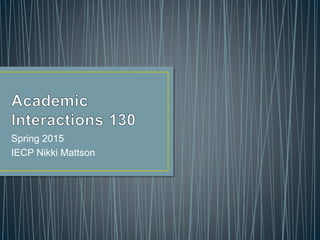5. gender and society
•Descargar como PPTX, PDF•
2 recomendaciones•1,247 vistas
I
IECPDenunciar
Compartir
Denunciar
Compartir

Recomendados
Recomendados
Increasingly rigorous adult ESL classes are a reality, and one area of focus is academic language. Do adult ESL teachers know how to integrate academic language at all levels of instruction? This session focuses on promising practices for teaching academic language from beginning through intermediate levels of adult ESL.Parrish_Vinogradov Helping Adult ELs Meet Language Demands of College & Careers

Parrish_Vinogradov Helping Adult ELs Meet Language Demands of College & CareersMinnesota English Learner Education Conference
Más contenido relacionado
La actualidad más candente
Increasingly rigorous adult ESL classes are a reality, and one area of focus is academic language. Do adult ESL teachers know how to integrate academic language at all levels of instruction? This session focuses on promising practices for teaching academic language from beginning through intermediate levels of adult ESL.Parrish_Vinogradov Helping Adult ELs Meet Language Demands of College & Careers

Parrish_Vinogradov Helping Adult ELs Meet Language Demands of College & CareersMinnesota English Learner Education Conference
La actualidad más candente (20)
When Guided Reading Isn't Enough Guidance - Challenging Young Talented Readers

When Guided Reading Isn't Enough Guidance - Challenging Young Talented Readers
Parrish_Vinogradov Helping Adult ELs Meet Language Demands of College & Careers

Parrish_Vinogradov Helping Adult ELs Meet Language Demands of College & Careers
Belonging and Mattering - Professor Jacqueline Stevenson

Belonging and Mattering - Professor Jacqueline Stevenson
Engaging Adolescent Readers (Great Smokies Reading Council)

Engaging Adolescent Readers (Great Smokies Reading Council)
Evidence Guided Literacy Oct 2019 - without children

Evidence Guided Literacy Oct 2019 - without children
Similar a 5. gender and society
The presentation will introduce you to the different ways teachers can help learners to be better prepared for life in the 21st century. There are many ideas which teachers are already using every day such as Global Awareness and Cross Curricular Skills, Critical Thinking and Problem Solving, Communication and Collaboration. The author of the presentation reflects on how we can develop such skills while teaching English to our students.
21st century skills. Some ideas about teaching english today and tomorrow.

21st century skills. Some ideas about teaching english today and tomorrow.The BKC-IH Teacher Training Centre
Similar a 5. gender and society (20)
21st century skills. Some ideas about teaching english today and tomorrow.

21st century skills. Some ideas about teaching english today and tomorrow.
Adolescent problems and class room managment Management Concepts - Manu Melw...

Adolescent problems and class room managment Management Concepts - Manu Melw...
Resource Personal Action Plan Observation InstructionsConduct.docx

Resource Personal Action Plan Observation InstructionsConduct.docx
Más de IECP
Más de IECP (20)
PPT FINAL_WISE 2024 PSU: Intercultural Connections

PPT FINAL_WISE 2024 PSU: Intercultural Connections
20. interview introduction, genome synthesis, vt commenting

20. interview introduction, genome synthesis, vt commenting
18. oral citation and genomic sequencing presentations

18. oral citation and genomic sequencing presentations
4. modal verbs, inclusive language, verb identification

4. modal verbs, inclusive language, verb identification
5. gender and society
- 1. Spring 2015 IECP Nikki Mattson
- 2. YingYing Yousff Ahmed Hibatullah Martin Khaled Salim Omar Saeed Xun Bayan Dina Sarah Zainab Almishaal Zhicheng Medhat Moha mmed Abdulla Hala Rahmah Amal Maryam Zainab
- 3. Vanny Sunny Maad Mona Abdulla Chao Ann Salim Hassan Maryam Yi-Chin Abdullah Riyad h Malek Ananda Chia Mohammed Ahmed Kholood Ai-Hsing
- 4. • Pathways, chapter 1 • Gender and Society (concepts and vocabulary) • Introduction to Conversation Starter assignment
- 5. • Read through the topics and skills from pages iv-vii. • From the “scope and sequence” pages, what topics and skills are you particularly interested in? • Share your interests with your group
- 6. • What is the difference between the words “gender” and “sex”? http://www.med.monash.edu.au/genderme d/sexandgender.html
- 7. 1. What kinds of behaviors/attitudes/actions do you consider to be masculine? 2. What kind of behaviors/attitudes/actions do you consider to be feminine? 3. Do you think your beliefs about what is feminine and masculine are shaped by the culture of your home country? If so, how? 4. Can you think of any examples of masculinity and femininity that are different from your own ideas? (e.g. I think physical fighting is more masculine).
- 8. • Williams and Best (1982) studied 30 countries and found high cross-cultural agreement on the adjectives used to describe males and females. • In all countries, adjectives associated with men were rated as being stronger and more active. • Participants from Japan and South African rated male characteristics as more favorable; Italy and Peru rated female characteristics more favorable.
- 9. • Follow up studies by Williams and Best (1990) • Men are viewed as active, strong, critical, conscientious, extraverted, and open. • Women are viewed as passive, weak, nurturing, adaptive, agreeable, and neurotic.
- 10. • Do you agree or disagree with any of these stereotypes (in particular)?
- 11. • Video
- 12. What do you think of this practice of fighting cholitas?
- 13. • Read pgs. 2-3 and complete the discussion questions with your group.
- 14. • Using context (how does this work?) • Parts of speech (what are they and how do you know?) • Pg. 4, listening • Pg. 5, complete B and C individually • Pg. 5, complete part D as a group
- 15. • Goal: to use new vocabulary words in the contexts of our academic fields. • I will choose several conversation starters to be discussed in class. • http://ai130sp15.blogspot.com/
- 16. • Add one conversation starter (Pathways, Pg. 5) to the Google Doc by midnight tonight (Tuesday)